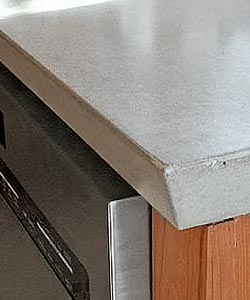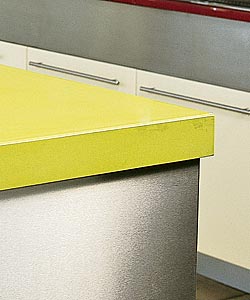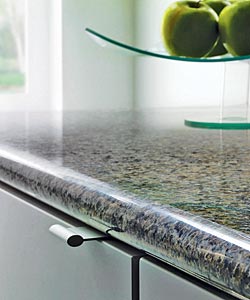 |
 |
A. Although limestone is lovely—warm, natural, and interesting (you can find seashells and fossils embedded in it)—it can be a frustrating surface for food preparation. Gerry Santora, an owner at Soupcan (1500 S. Western Ave., 312-243-6928; soupcan.com), says, "It’s so alkaline, it will etch just by looking at it." His firm sells sinks and countertops made from pre-cast concrete, a material he prefers. "Even something only mildly acidic, such as milk, will etch limestone," he says. "It’s a whitish discoloration, a reaction kind of like a chemical burn, and the only way to get rid of it is to have it repolished."
Oil creates another kind of problem; spill some on a limestone counter and a dark stain will form that’s almost impossible to remove. You can get proactive and treat the counter with a penetrating sealer, but it may not be not totally effective in protecting against oil stains, Santora says. One kitchen designer we talked to went so far as to say that if you cook with oil, don’t get limestone.
|
|
Polished stone is less susceptible to staining than honed stone, which has a matte finish, says Bill Tobias, the owner of Michael Remi Designs (2642 W. Fullerton Ave., 773-252-6300; michaelremi.com). But polished marble and limestone will still etch when exposed to acidic foods. And even though a polished surface provides some protection, many experts recommend treating a polished countertop, such as granite, with a sealer, and reapplying it once a year.
In recent years, granite has become the countertop superstar because it’s hard and durable, rich and varied in pattern and color, and also scratch-, heat-, and stain-resistant. But it’s ubiquitous and you might be tired of it even before you’ve installed it in your kitchen.
Two other stones to consider for your countertops are slate and soapstone. Both are nonporous and therefore antibacterial and stain resistant, says Char Pearson, design manager of Prairie Plus (509 Madison St., Oak Park, 708-848-4218; soapstonetops.com).
And they are both heat resistant; you can put a hot pan right on the surface. Slate, an elegant choice, is a hard stone that comes in a range of muted colors: gray, black, red, purple, and turquoise. Soapstone has the cozy familiar look of a farm kitchen or your high school chemistry lab. It comes in black, gray, and a greenish black. Soapstone’s relative softness makes it vulnerable to scratches and dings, but it tends to have a lot of veining and variation in color, so dings are not that noticeable. You can rub them out with a paper towel and mineral oil or fine sandpaper if they bother you. To learn more about stone countertops in general, check out findstone.com and a useful blog at thekitchendesigner.com.
A rule of thumb when you’re dealing with natural materials is that you have to accept a degree of unpredictability in how these surfaces behave. If you love the stone aesthetic but hate its crazy ways, consider the engineered quartz countertops made by Silestone (silestone.com), CaesarStone (caesarstone.com), and a few other companies.
Made of about 93 percent quartz and 7 percent pigments and resin, these materials can be polished or honed, don’t have to be sealed, won’t scratch or stain, and are heat resistant (though a trivet is recommended for pots and pans right out of the oven, as is a cutting board when you’re slicing and dicing). Engineered quartz comes in a variety of patterns that look like natural stone and in colors from earth tones to vibrant reds, yellows, oranges, and greens.
JUST ASK Have a design or renovation question? We’ll do our best to answer it.
E-mail us at chicagohome@chicagomag.com. Sorry, we cannot take questions by phone, or guarantee individual responses.



